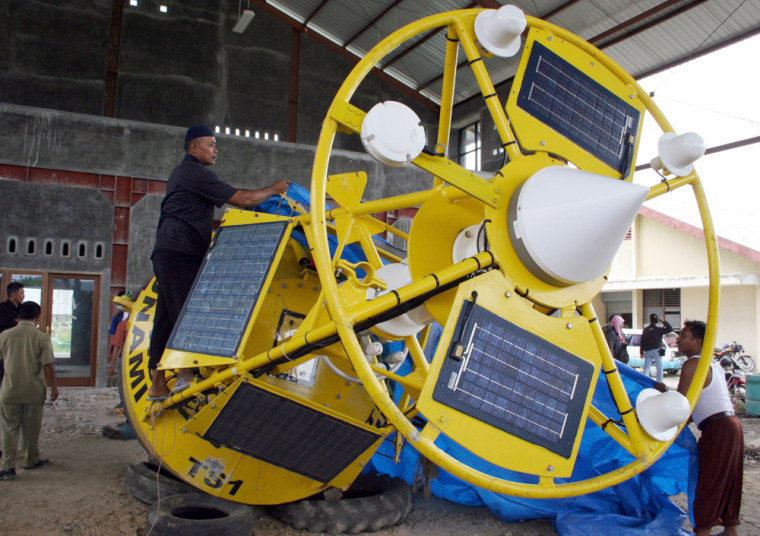Lack of funds has crippled the creation of a tsunami warning system, leaving earthquake-prone Indonesia without a single working detection buoy, an official said on Tuesday, a day after a tsunami killed more than 340 people.
No sirens alerted residents in Pangandaran beach, the worst-hit area of Monday’s tsunami, after a 7.7 magnitude quake struck 110 miles offshore in the Indian Ocean.
Edi Prihantoro, an official at Indonesia’s Ministry of Research and Technology that oversees a national warning project, said the southern Java area had no system to warn people of coming waves.
His comments came as a government minister said Indonesia had received warnings from two regional agencies that the powerful undersea earthquake had the potential to trigger a tsunami, but it did not try to pass them on to threatened communities.
Science and Technology Minister Kusmayanto Kadiman said Indonesia received the bulletins from the Pacific Tsunami Warning Center and Japan’s Meteorological Agency after the quake, but “we did not announce them.”
The warnings were sent about 45 minutes before the tsunami struck.
Even if the government had an attempt to contact the local authorities by phone, radio or e-mail, it’s unclear how those warnings would have been passed along to residents or tourists on the beach with no system of sirens or alarms in place.
Coastal residents reported that they did not feel the earthquake.
Two sensors damaged
Indonesia deployed two tsunami buoys last year off Sumatra island, part of a five-year project to install similar detectors all around the world’s largest archipelago.
But when asked how many of them were operational, Prihantoro said: “None.”
“We need at least 22 buoys to cover all of Indonesia. We have received two from Germany and they were deployed months ago. However, both of them are damaged now,” he said.
Both have since been removed from the sea and one of the damaged buoys is sitting in a warehouse in west Sumatra awaiting repairs.
The death in a dozen Indian Ocean countries of more than 230,000 people -- more than two-thirds in Indonesia’s far-western Aceh province -- from a huge tsunami in December 2004 prompted international calls for a global warning system.
But international support and funding has waned since then. Prihantoro said Indonesia could not proceed without international aid and so far there had been no clear pledges to fund the other 20 buoys.
“Why is the realization of this project so slow? It is because we do not have the funding. Neighboring countries must also take care of this matter otherwise they will also feel the impact,” he said.
Indonesia’s 17,000 islands sprawl along a belt of intense volcanic and seismic activity, part of which is called the “Pacific Ring of Fire”.
Quake underestimated
The nation’s state meteorology agency initially underplayed the strength of Monday’s quake, rating it at a magnitude of 5.5, and said the tremor would not cause a serious tsunami. It revised that much later to a more dangerous 6.8, but by then the waves had already struck Java’s south coast.
The U.S.-based Pacific Tsunami Warning Center recorded the quake at magnitude 7.2 but said a tsunami would only affect areas 60 miles from the epicenter.
“A destructive widespread tsunami threat does not exist based on historical earthquake and tsunami data,” it said, adding a local tsunami could “affect” nearby coastlines.
However, seismologists say the link between a big quake and a powerful tsunami remains something of a mystery.
“From an earthquake alone you will never tell how big the tsunami will be. That’s a wild card in any tsunami,” said Gary Gibson, a senior seismologist at Australia’s Seismology Research Center.
But that's exactly how digital tide gauges and sophisticated buoys with seabed pressure sensors, part of the ambitious five-year tsunami alert plan, could help protect Indonesia.
“We really need to raise this issue. We cannot do it alone,” said Idwan Suhardi, a deputy minister at Indonesia’s Research and Technology Ministry.
